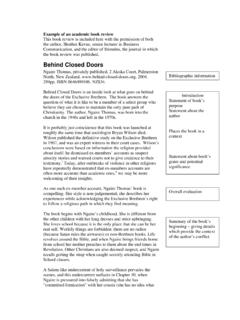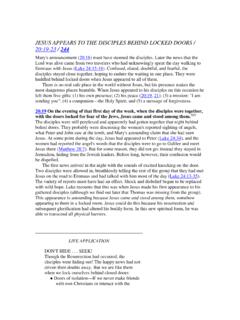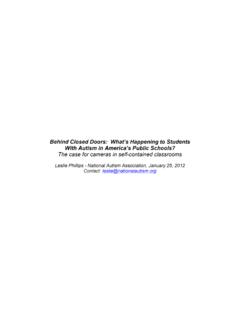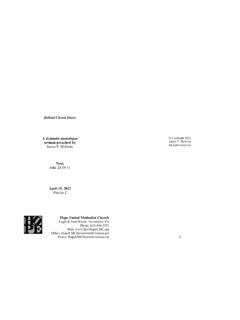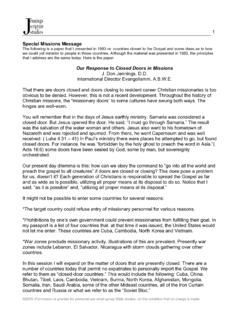Transcription of Behind Closed Doors
1 Behind Closed Doors A Report by the Stop Dioxin Exposure Campaign 2001 For more information or to order copies of this publication contact: Center for Health, Environment and Justice Box 6806 Falls Church, Virginia 22040 Voice: 703-237-2249 E-mail: Website: Behind Closed Doors Stop Dioxin Exposure Campaign 2 Behind Closed Doors ACKNOWLEDGEMENTS Monica Rohde, the Center for Health, Environment and Justice s Stop Dioxin Exposure Campaign Coordinator, deserves special thanks and recognition. Monica spent tireless hours collecting and compiling data and information on dioxin, politics, and the chemical industry. She also dedicated numerous hours to the coordination, writing, editing, and preparation of this report. Special thanks also go to Science Director, Stephen Lester and Research Associate, Ron Nicosia for their hours of reviewing, editing and fact checking.
2 Dioxin Campaign Intern Emma McCauley deserves special thanks her work in the development of this report as does Barbara Sullivan for the layout. We d also like to thank Patty Lovera for reviewing several drafts of this report. We would like to thank Lisa Kleven and Celia Davis from the Data Center in Oakland, California for researching and collecting the data and articles, which provided the foundation of this report. Copies of this report are available from Center For Health, Environment and Justice Box 6806 Falls Church, VA 22040 703-237-2249 Behind Closed Doors Stop Dioxin Exposure Campaign 3 TABLE OF CONTENTS Preface Executive Summary Section 1. Chemical Industry Initiatives to Discredit and Stall the Release of the EPA s Dioxin Reassessment Conflict of Interest: How the Chemical Industry Stacks Scientific Peer Review Panels Public Participation: The Chemical Industry s Attempt to Ram Through a Policy that Would Squash Freedom of Speech Bait and Switch: Science Advisory Board Report on November Meeting Lawsuits: A Way to Conceal Information from the Public Stall Tactics: Delay is the Name of the Game Section 2.
3 Chemical Industry Efforts to Block Local Initiatives on Dioxin Section 3. Chemical Industry Influence during the Treaty Negotiations on Persistent Organic Pollutants (POPs) The Chlorine Chemistry Council Takes the Delegation Hostage The Chemical Industry Seeks to Eliminate Elimination Section 4. The Chemical Industry and Electoral Politics References Appendix A Timeline of Events Appendix B What is Dioxin? Appendix C Chemical Industry Support for Bush and Whitman Behind Closed Doors Stop Dioxin Exposure Campaign 1 PREFACE Behind Closed Doors is the latest eye-opening and groundbreaking report from the Stop Dioxin Exposure Campaign. The campaign is a network of hundreds of environmental justice groups, religious leaders, health care professionals, scientists and health impacted groups, representing thousands of people across the country. The campaign is coordinated by the Center for Health, Environment and Justice, in Falls Church, Virginia.
4 In 1991, grassroots activists from across the country fighting dioxin-polluting facilities came together in Chapel Hill, North Carolina to attend the 1st Citizen's Dioxin Conference. The gathering was aimed at providing community groups the opportunity to hear leading scientists from around the world report on their research on the health effects of dioxin. The 2nd Citizen's Dioxin Conference, held in 1994 near Times Beach, Missouri a town evacuated in the early 1980s because of dioxin contamination brought together community groups working to shut down or block dioxin polluting facilities such as incinerators, pulp and paper mills, and PVC manufacturing facilities. Strategies to end dioxin exposure were discussed as part of this meeting. A year later, at a roundtable meeting in Arlington, Virginia, community leaders came together to plan a nationwide grassroots campaign to stop dioxin exposure.
5 A key element of this campaign was to pressure the United States Environmental Protection Agency to finalize and release the reassessment of the health effects of dioxin that the agency had begun in 1991. The Stop Dioxin Exposure Campaign was officially kicked off in 1995 with the release of Dying from Dioxin: A Citizen's Guide to Reclaiming Our Health and Rebuilding Democracy. The first of half Dying from Dioxin describes how dioxin is destroying the health of the American people and is based largely on the EPA s 1994 draft reassessment document on dioxin. The second half is devoted to organizing a campaign to reclaim our health by eliminating dioxin exposure. The ultimate goal of the campaign is to achieve a sustainable society in which there is no dioxin in our food or breast milk because there is no dioxin formation, discharge, or exposure.
6 To achieve this goal, the campaign is committed to: 1. Halting all incineration, including medical waste incinerators; municipal waste incinerators; hazardous waste incinerators; military waste incinerators; sewage sludge incinerators; and hazardous waste Behind Closed Doors Stop Dioxin Exposure Campaign 2 burning in cement and aggregate kilns, boilers, and industrial furnaces; 2. Exposing and challenging dioxin assaults on low-income communities and communities of color; 3. Phasing out industrial uses of chlorine, including its use in pulp and paper manufacturing and in PVC plastics, and include provisions for affected workers; 4. Identifying more clearly the various sources of dioxin; 5. Determining the levels of dioxin in food and breast milk so that the progress of the campaign can be measured; 6. Promoting safe, alternative jobs, products and technologies.
7 These goals were adopted at the 3rd Citizen's Dioxin Conference in 1996 in Baton Rogue, Louisiana and reaffirmed at the 4th Dioxin Conference in August, 2000 in Berkeley, California. In November of 1999, the campaign released America's Choice: Children's Health or Corporate Profits. This peer-reviewed report summarizes new scientific research on the toxic effects caused by or associated with dioxin exposure. The report builds on the scientific data on health effects described in the EPA's 1994 draft dioxin reassessment and includes studies published since the draft's release. In addition, America's Choice outlines specific policy initiatives that state and local governments can take to eliminate dioxin. The report is intended to inform the public and their representatives in government so appropriate action can be taken to safeguard the health of the American people.
8 Following the release of that report, public hearings were held in thirteen locations as a way of engaging elected officials in a dialogue for adopting policies that will protect the public's health. Throughout the 1990s, community groups have been successful in shutting down and blocking hundreds of municipal and medical waste incinerators. Communities have also been successful in introducing local and state policy initiatives that protect the public from dioxin exposure. However, no matter how successful our efforts have been at a local and state level, we have been unable to move the federal government. The primary reason for this is the chemical industry s ability to block policies that would protect the public. This is why we are now releasing Behind Closed Doors . It is time for the American people to know how the chemical industry, like the tobacco industry, has been using its backdoor influence to preserve its profits at the expense of public health.
9 Lois Marie Gibbs Behind Closed Doors Stop Dioxin Exposure Campaign 3 EXECUTIVE SUMMARY The chemical industry does not want you to read this report. Behind Closed Doors reveals evidence about how the chemical industry has methodically and strategically attempted to influence policy makers and conceal from and mislead the public about the health impacts of dioxin. Just as with the tobacco industry, the public is demanding that the chemical industry be brought to justice. The primary players in this deception are the American Chemistry Council (ACC), formerly the Chemical Manufacturer's Association, and the Chlorine Chemistry Council (CCC). The American Chemistry Council is a trade organization representing hundreds of chemical companies. The Chlorine Chemistry Council, a division of the ACC, works on policy issues that affect the way its members conduct business.
10 Under the leadership of Fredrick Webber, president of the American Chemistry Council and "Kip" Howlett, executive director of the Chlorine Chemistry Council, the CEOs of dioxin-generating companies and the lawyers and public relations firms that represent them have launched an all-out campaign to hide from the public the link between dioxin and cancer and other serious health disorders. Public awareness of the danger dioxin poses to public health would significantly impact policies that regulate dioxin-generating companies. At the center of the debate are two policy approaches: 1) dioxin elimination vs. dioxin control, and 2) precaution vs. risk management. For any dioxin policy to have a chance at meaningful impact, it must have at its core a commitment to eliminating dioxin. What is required are policies that prohibit the creation of dioxin in the first place, instead of the current practice of trying to control dioxin after it has been produced.
